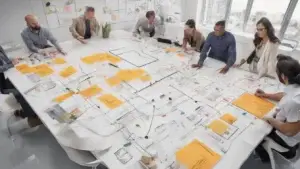

The 2:47 AM email that changed everything wasn’t from an insomniac client. It was from an AI system representing a Fortune 500 company, autonomously negotiating terms for a strategic transformation project. No human had touched the RFP. The algorithm had analyzed capabilities, reviewed thought leadership, assessed cultural fit, and initiated contact.
Welcome to professional services in 2025.
Professional services face an existential crisis that goes far beyond “efficiency improvements” or “digital transformation.” The industry’s fundamental value proposition—expertise plus time equals premium pricing—is collapsing in real time.
The brutal mathematics are undeniable:
But the disruption cuts deeper than automation. Three converging forces are reshaping the entire landscape:
The Expertise Paradox: Knowledge becomes obsolete faster than we can acquire it. Traditional career paths—apprentice to expert over decades—collapse when expertise has a half-life measured in months.
The Trust Revolution: Clients no longer buy credentials; they buy transformation. They can access world-class expertise through AI, find specialists globally via platforms, and verify results through transparent ratings.
The Meaning Crisis: As AI handles routine expertise, humans hunger for what only humans provide: wisdom, connection, purpose. Yet most firms still sell intelligence when clients crave insight.
The question isn’t whether your firm will be affected. It’s whether you’ll lead the transformation or become its casualty.
The firms thriving in this chaos share a profound insight: In a world of accelerating change, the goal isn’t to predict the future—it’s to build practices that get stronger from uncertainty.
This requires what I call “antifragile architecture”—designing professional services that don’t just survive disruption but feed on it. Like earthquakes that strengthen certain geological structures, market volatility and technological change become sources of competitive advantage.
1. Design for Evolution, Not Stability
Traditional firms optimize for efficiency and predictability. Antifragile practices optimize for adaptability and learning. They implement:
2. Market Through Movement, Not Messages
The old model: Broadcast expertise to attract clients. The new model: Build communities that generate transformation.
This means:
3. Grow Through Ecosystems, Not Headcount
Linear growth has limits. Exponential impact requires platform strategies:
4. Transcend Traditional Boundaries
The highest evolution isn’t building bigger firms—it’s creating lasting transformation:
Early adopters of antifragile architecture aren’t just surviving—they’re defining entirely new categories of value creation.
Firms applying AI-native thinking report 400% increases in revenue per professional. They’ve moved from selling time to architecting transformation, using AI to explore exponentially more strategic scenarios while human experts focus on synthesis and judgment.
One consulting firm now records every strategy session, automatically analyzes insights, and feeds learning back into their institutional knowledge graph. New consultants can query thousands of hours of senior partner thinking. It’s like having every expert in the firm on speed dial.
AV/IT/Security consulting firms embracing ecosystem strategies have transitioned from project-based contractors to strategic partners managing entire digital ecosystems. They’re building smart building platforms that generate recurring revenue, continuous optimization insights, and predictive maintenance capabilities.
Law firms and other knowledge-intensive practices are discovering that AI doesn’t replace lawyers—it multiplies them. One legal strategist can now analyze regulatory landscapes across multiple jurisdictions simultaneously, while AI handles routine document review and compliance checking.
Meanwhile, practices still competing on traditional metrics face mounting pressure:
Every professional services leader faces a fundamental choice: Continue optimizing a dying model or architect an entirely new one.
The transformation window is narrow but the opportunity is unprecedented. The firms that act now—building antifragile architecture while competitors debate AI policies—will capture exponential advantages in capability, efficiency, and value creation.
This isn’t about adding AI tools to existing processes. It’s about reimagining the entire foundation of professional services:
The mathematics are clear: Firms that master this transition will achieve 5-10x performance improvements while their competitors struggle with single-digit gains.
The complete blueprint for navigating this transformation—including detailed frameworks, implementation guides, and real-world case studies—will be available in the fourth edition of “The Architecture of Value,” publishing in October 2025. This isn’t just another business book. It’s a survival manual for the most significant disruption professional services have ever faced. And an opportunity to guide those ready to lead it.
The clients arriving at 2:47 AM aren’t anomalies. They’re the new normal. The question is whether you’ll be ready for them.
The future belongs to practices that don’t just survive change—they strengthen from it. Build that, and you don’t just endure the transformation of professional services.
You lead it.
Share this post: